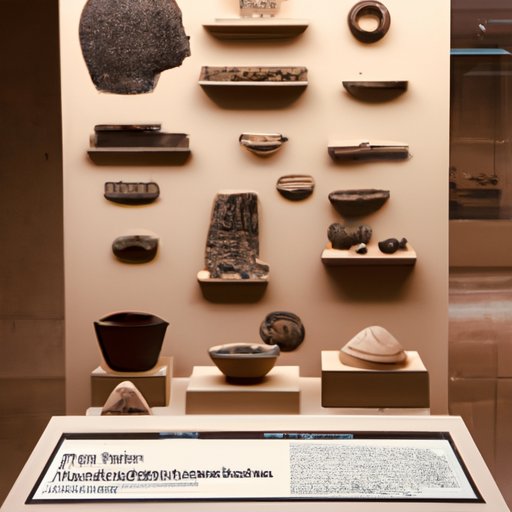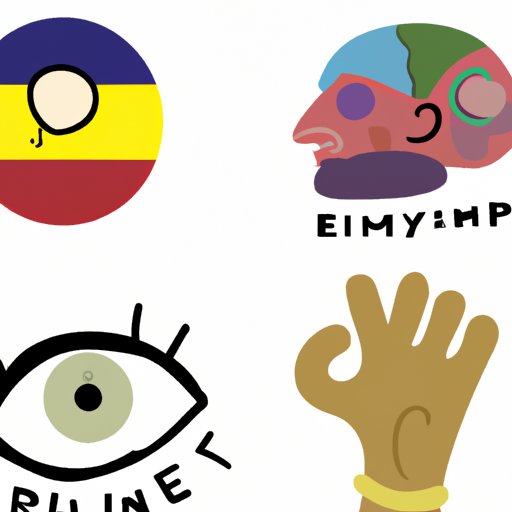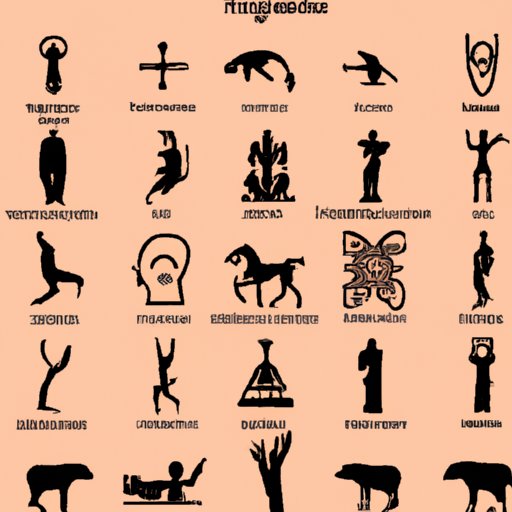Introduction
Cultural symbols are defined as visual or auditory representations that convey a particular idea, value or belief. They can take many forms, including logos, images, words, sounds and gestures, and they are often used in various aspects of culture, such as art, literature, music, dance, rituals, advertising and more. This article will explore cultural symbols from a historical, artistic and anthropological perspective, as well as compare symbols across different cultures to gain a better understanding of their meaning.

Historical Overview of Cultural Symbols
The use of symbols dates back to ancient times, with evidence of their use in Ancient Egyptian hieroglyphs, Chinese characters and Mayan iconography. These symbols often represented ideas, values and beliefs of the culture, and could be found on monuments, architecture and artwork. Over time, symbols have evolved to become more abstract and symbolic of broader concepts. For example, the American flag is now widely recognized as a symbol of freedom and democracy.
Examining Cultural Symbols Through Art and Literature
Cultural symbols can be found in a variety of visual arts, such as painting, sculpture and photography. Many of these works serve as a means of expressing ideas, values and beliefs through symbols. In literature, authors often use symbols to represent characters or ideas. For example, the white whale in Herman Melville’s novel Moby-Dick is seen as a symbol of evil and destruction.
Exploring Cultural Symbols in Music, Dance and Rituals
Music, dance and ritual are all forms of expression that rely heavily on the use of symbols. In music, symbols are often used to convey emotion or convey a message. For example, the song “We Shall Overcome” has become a symbol of hope, strength and resilience. Similarly, in dance, symbols are often used to express feelings or tell a story. In rituals, symbols are used to invoke certain ideas or beliefs. For example, the burning of incense is a common ritual that is used to symbolize purification and protection.

Investigating the Meaning Behind Cultural Symbols
Anthropologists have studied cultural symbols to gain a better understanding of their meaning and how they influence behavior. One popular theory is known as the “semiotic triangle” which suggests that there is a relationship between symbols, objects and ideas. According to this theory, symbols can be used to represent ideas, values and beliefs, and can even be used to manipulate behavior. For example, the swastika is a symbol that is associated with Nazism and has been used to evoke fear and hatred.

Analyzing the Use of Cultural Symbols in Advertising
Advertising is one area where symbols are widely used to influence consumer behavior. Companies often use symbols to create an emotional connection with consumers, such as the Apple logo which is associated with creativity and innovation. Symbols can also be used to create a sense of familiarity and trust, such as the McDonald’s golden arches which are a symbol of quality and reliability.
Comparing Cultural Symbols Across Different Cultures
When comparing symbols across different cultures, it is important to consider the context in which they are used. While some symbols may be universal, others may have different meanings depending on the culture. For example, the color red has different connotations in different cultures. In Western culture, it is often associated with love and passion, while in Eastern culture it is often associated with luck and prosperity.
Understanding How Cultural Symbols Evolve Over Time
As culture evolves, so too do its symbols. Symbols can become outdated or irrelevant over time, or they can be adapted to fit new contexts. For example, the peace sign was originally designed as a symbol of anti-war protest but has since been adopted by many brands as a symbol of peace and harmony. Similarly, the heart symbol has been adapted to represent love and friendship in many cultures.
Conclusion
In conclusion, cultural symbols are powerful representations of ideas, values and beliefs. They can be found in a variety of forms, such as art, literature, music, dance and rituals, and they are often used in advertising to influence consumer behavior. By examining symbols from a historical, artistic and anthropological perspective, we can gain a better understanding of their meaning and how they evolve over time. Finally, by comparing symbols across different cultures, we can gain insight into the similarities and differences between them.
(Note: Is this article not meeting your expectations? Do you have knowledge or insights to share? Unlock new opportunities and expand your reach by joining our authors team. Click Registration to join us and share your expertise with our readers.)
